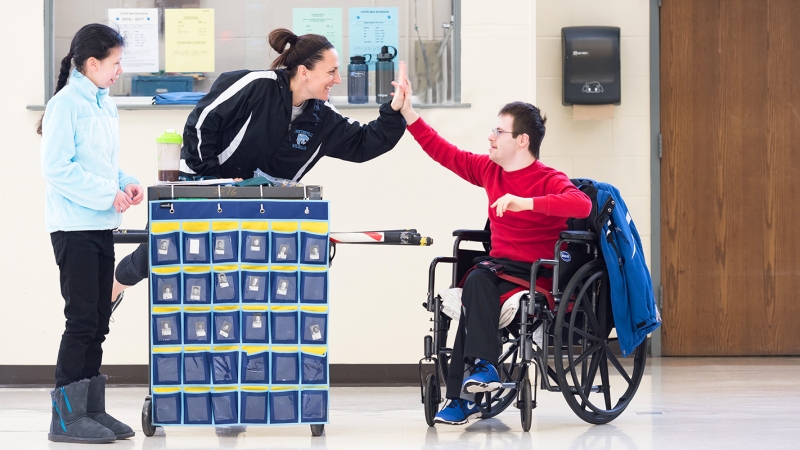Program Profile: Applied Behavior Analysis Program
Details and data for the 2023-24 School Year
Program Overview
The preschool, elementary, and secondary Applied Behavior Analysis (ABA) program has a primary objective of preparing students with autism and related disabilities to function as independently as possible in a variety of settings through the use of the principles of Applied Behavior Analysis (ABA). Applied Behavior Analysis, including Skinner’s analysis of Verbal behavior, is utilized as the fundamental approach to address behavioral challenges and teach new skills. ABA is a research-based intervention that has been demonstrated to be effective for children with autism and related disorders (Cooper, Heron, and Heward, 2019; Autism Center for Excellence, 2013; Rogers and Vismara, 2008; United States Surgeon General, 1999; New York State Department of Health, 1999). This instructional approach emphasizes the importance of looking at the A-B-C's (antecedents, behaviors, and consequences) of behaviors, teaching new behaviors, and developing systematic instructional plans to teach new skills. Skills are broken down into small units through task analysis. New skills are taught through the systematic use of ABA techniques such as reinforcement, shaping, prompting, fading, chaining, extinction, and discrimination (Goldstein, 2002; Odom et.al, 2003, and McConnell, 2002; American Psychiatric Association, 2000). Data collection and analysis is an important component of an ABA instructional program. Data is used to measure progress on the acquisition of new skills and behaviors and to analyze the success of individualized strategies used for instruction.
Program staff members provide direct coaching support to classroom instructional personnel and provide professional development events that focus on teaching technique, classroom management, behavior strategies, and communication skills. Research supports a coaching and professional development model that includes components consisting of didactic, performance feedback, rehearsal, and direct coaching. This model produces rapid and sustainable improvements in teacher’s implementation of ABA. (Cullen, 1988; Delamater, et al, 1984; Demchak et al., 1992; Fielding, et. al., 1971; Fleming, et al., 1996; Gladstone & Spencer, 1979; Greene, et al., 1978; Harchik, et al., 1989); Johnoson &Fawcett, 1994; Krumhus & Malott, 1980; Matson, 1990; Neef et al., 1986; Parsons & Reid, 1995; Parsons, et al., 1996; Reid & Green, 1990; Richman, et al., 1988; Sepler & Meyers, 1978; Sarakoff and Sturmey, 2004; Touchette & Howard, 1984). In addition, teachers who learned to generalize these skills were able to improve learning outcomes across a variety of student academic and behavioral profiles. (Koegel, Russo, and Rincover, 1977)
Services for all 2844 students in the program are delivered, consistent with students’ individualized education programs (IEP), through a continuum of placement options that include schools, autism programs and center sites. The Enhanced autism classes at the elementary level are a part of the continuum of available services for eligible students. Instruction is based on the individual needs of students and services range from support in the general education settings, to specialized instruction in small, self-contained special education classes in neighborhood schools.
Preschool Autism Classes (PAC) are available for preschool-aged students with autism who are found eligible for services and have an IEP that outlines a requirement for specialized instruction using applied behavior analysis. The following features differentiate services provided in the PAC program:
- Instruction using ABA and Verbal Behavior (VB) principles
- Specially trained instructional and support staff
- Full day classes
- Low student to staff ratio
- Uniform data collection system
- Regularly scheduled support from an ABA Coach
- Fall and spring assessment (VB-MAPP)
The Preschool Program of Studies used as the curriculum in PAC. Additionally, the following instruction is included in PAC:social skills, imitation, behavior, language, motor, self-help, play, and pre-academics.
Eligible students with autism at the elementary level may participate in Enhanced Autism classes (EAC) if they require ABA because of their complex instructional, language and behavioral profile. The instructional program for students in the enhanced autism classes is guided by the general education curriculum with an additional focus on behavior management, communication, social skills, and life skill development. Teachers provide academic instruction that is individualized based upon students' current level of performance and rate of learning.
The following additional features differentiate services in the enhanced autism classes:
- Instruction using ABA and Verbal Behavior (VB) principles
- Specially trained instructional and support staff
- Low student to staff ratio
- Students may access general or adapted curriculum
- Uniform data collection system
Regularly scheduled support from an ABA Coach Principles and strategies of ABA are also applied to the instruction of students with Autism and other low incidence disabilities at the secondary (middle and high school) level.
PAC students are assessed twice a year with the Verbal Behavior Milestones Assessment and Placement Program (VB-MAPP).
EAC students may be assessed with either SOLs or VESOLs depending on their needs.
Additionally, a Brigance may be used twice a year for additional information.
A variety of instructional materials are available for students who are accessing an adapted curriculum. Students may access specialized reading and math programs. Reading Programs:
- Reading Mastery
- Corrective Reading Comprehension
- Corrective Reading Decoding
- Early Literacy Skills Builder (elementary)
- Early Literacy Skills Builder for Older Students (secondary)
- Early Reading Skills Builder (ERSB)
- Language for Learning (elementary)
- PCI Reading Program
- Pathways to Literacy (elementary)
Mathematics Programs:
- Access Algebra (secondary)
- Connecting Math Concepts
- Early Numeracy Curriculum (elementary)
- Hands-On Math (supplemental)
- Math Skills Builder (secondary and supplemental)
- Teaching to Standards: Math (secondary)
- Continue to improve the quality and variety of ABA training and support to schools by offering more advanced technical training topics.
- Forge partnerships with a variety of agencies and community organizations outside Fairfax County Public Schools to expand network, sharing of information accessibility for parents.
- Integrate technology and web-based modules into professional development training
The ABA team supports improved outcomes for students by working collaboratively with other DSS staff members to provide direct and indirect coaching support, and professional development.
Training and Professional Development
The PreK-12 Applied Behavior Analysis program targets the professional development and direct support needed for the implementation of ABA and VB instructional techniques. Training opportunities are offered throughout the year to teachers, instructional assistants, school administrators and parents. Core training for all instructional staff includes:
- ABA Fundamentals
- Verbal Behavior Fundamentals
- ABA Beginning Hands-on Training (week-long, usually in the summer).
Advanced training opportunities were available for instructional staff this year on the topics of communication, proactive and reactive behavior strategies, writing IEP goals, data collection, teaching social skills, and developing replacement behaviors.
The ABA Team provided a total number of 116 county wide training during the 2022-2023 school with 7996 FCPS participants participating in the training. Additionally, the ABA Coaches offer trainings at the school-based level not included in the above total.
ABA Coaches
ABA coaches support services through an embedded coaching and training model that includes both central and school-based professional development. ABA coaching staff provided ongoing training and direct support to school staff to enhance the delivery of services using ABA methodologies in 102 preschool, 176 elementary, and 162 secondary classrooms in 153 schools. This included the development and implementation of individualized instructional curricula and behavioral programs, resulting in improved student outcomes.
Contact: Tina Wilkerson, [email protected]


